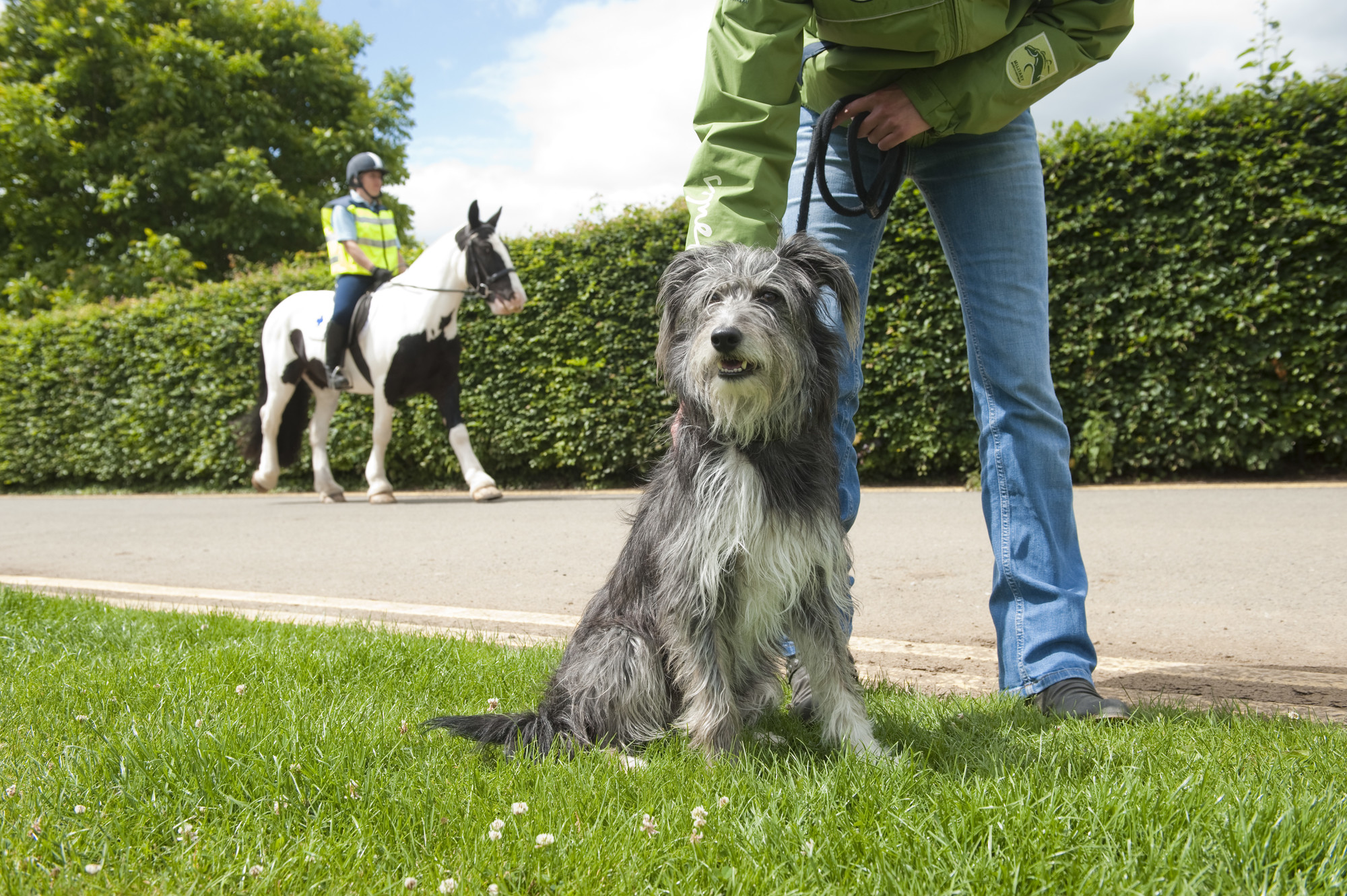
Keeping dogs and horses safe around each other
Understanding how dogs and horses are likely to react in each other's presence can help you to put steps in place to keep them safe.
Dogs and horses have different natural instincts that can cause them to behave in certain ways around each other. Dogs may feel frightened or excited around horses and react by chasing. This can be dangerous, as it can cause the horse to run or bolt.
Why is it important to keep dogs calm around horses?
If your dog is not used to seeing horses, they may feel scared or nervous when seeing a horse. They can react to this by investigating, chasing or barking.
Horses are natural prey animals, so if they see a dog running towards them or if they become startled, they're likely to bolt and run away. This can be very dangerous for you, your dog, the horse, the horse handler and the general public, because:
- if the area is open, the horse may run onto a busy road and risk being hit by a car, injuring the horse and the occupants of the car
- if your dog is chasing the horse onto the road, your dog could also be hit by a car
- the rider is at risk of falling off the horse and injuring themselves
- the horse could kick out – many horses have steel shoes on their hooves, which could cause serious injuries to your dog
- the horse can become injured if they are bitten by the dog
It's important to keep your dog on a lead around horses, to prevent a chase situation from happening.
Important
You are required by law to make sure your dog does not become dangerously out of control.
Why do dogs chase?
The ancestors of domestic dogs were natural predators, meaning they hunted other animals for food. As time went on, dogs were bred to be able to perform certain tasks better than others, such as chasing or hunting.
While most dogs today are kept as pets, knowing your dog's breed and their natural instincts can help you to understand how they could react in certain situations, including being around a horse for the first time. Some dogs may show a playful behaviour, but it's important to remember that the horse is unlikely to understand this.
Why do horses run?
Horses were prey for many large carnivores like wolves, so to survive they had to run away from any threat of attack. This is often referred to as ‘flight’ instinct. This natural survival instinct is strong, and as a rider or handler you'll have little influence over it. A bolting horse presents real danger to themselves and others, and can also entice a dog into a chase situation.
How to prevent your dog from chasing a horse
If your dog has never seen a horse before, they may react with a mixture of fear, curiosity or nervousness, which could result in barking or chasing. Here are some steps that can help keep your dog calm in the presence of a horse.
Socialise your dog with horses
Gradually socialising your dog with horses from a young age can help them learn to stay calm in the presence of horses.
This process should be done slowly, and from a distance on a lead. Rewarding your dog's calm behaviour with lots of treats can help them to understand that horses are not a scary or exciting animal to come across.
Read more on socialising your puppy.
Make sure your dog has good recall
It's important to work on your dog's recall so you can feel confident that your dog will return when called if you spot a horse. It's also a good idea to make sure that your dog can sit and stay when needed, as this will help to keep your dog under close control.
If your dog does not have good recall, it's best to keep them on a lead.
If you see a horse, allow them to pass
If you see a ridden horse and rider approaching, put your dog on a lead, stand in a visible but safe place and encourage your dog to sit still until the horse has passed. It's important to stand in a visible place, as the horse may become more frightened if they cannot see you.
If you see a rider approaching quickly, make yourself visible so they can slow to a walk before they pass you. If you’re on a bridleway, it’s a good idea to keep your dog on a lead at all times.
Remember to thank horse riders for slowing down while they pass your dog.
Tip
Wearing an item of brightly coloured clothing can help horse riders and handlers spot you and react at their earliest opportunity.
When to keep your dog on a lead
If there is public access through a field of horses, only enter if your dog is walking calmly on a lead. Remember that inquisitive horses may approach you and your dog. Release them if threatened or chased, so you can get to safety separately.
How to keep your horse calm around dogs
Communicating with dog owners when riding your horse can help to keep your horse calm, preventing them from bolting. Here's our tips.
Walk past dogs slowly
When walking past dogs, always slow to a walk and communicate with the dog owner at the earliest opportunity, to give them chance to call their dog to them. Remember, they may not have seen you, particularly if you are approaching from behind.
If the dog appears nervous, give them a wide berth to prevent the dog from feeling threatened. If you're riding in a group, go past in single file. Remember to always thank dog owners who keep control of their dog and allow you to pass them safely.
Socialise your horse with dogs
While socialising your horse with dogs can take a long time, it can help your horse to not feel frightened in a dog's presence. Allowing dogs around your horse's yard can help with this, however it's important to make sure that the dog is calm. A dog that is likely to chase or play can worsen your horse's fear.
Make sure you can be seen
Wearing high visibility equipment will allow dog owners to spot you as soon as possible, and take control of their dog. However, while it's important to be seen, do not shout or wave your arms around, as this can startle the dog or your horse.
Stay calm
If you see a dog approaching, it's important to stay calm yourself, as your horse will be able to sense your unease.
You can also keep your horse feeling calm by talking to them, scratching their neck and by letting your horse face the dog so they can see it. It's less frightening for your horse to see the dog, rather than having the dog behind them.
Stop if necessary
If necessary, stop walking to allow an excited dog to be caught.
Further training advice and a guided video is available from The British Horse Society.
Page details
Reviewed
• 6 December 2023
Next review
• 7 December 2026





